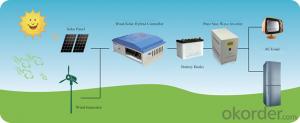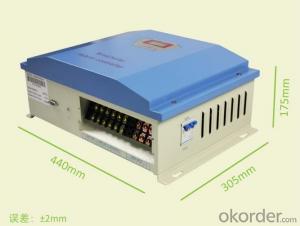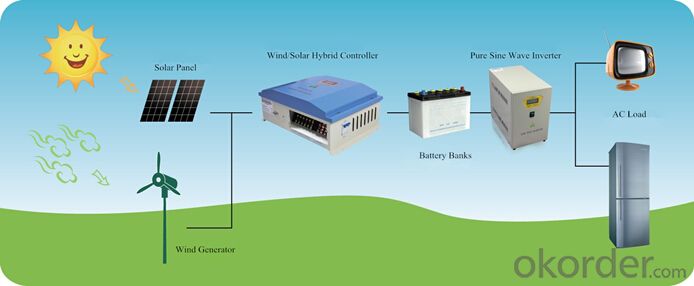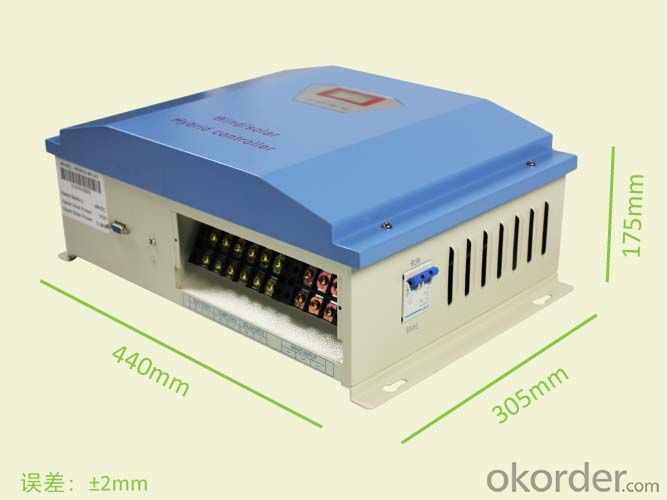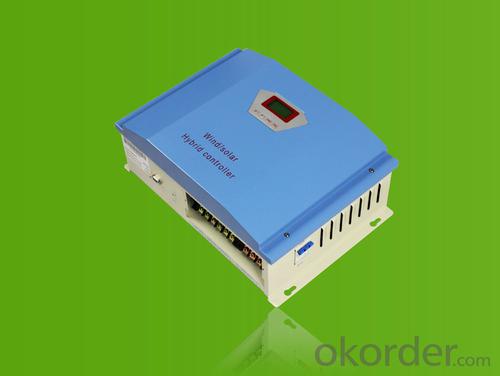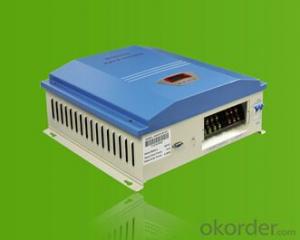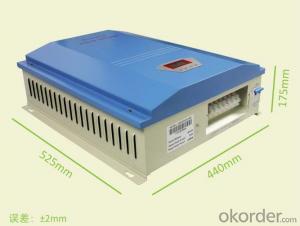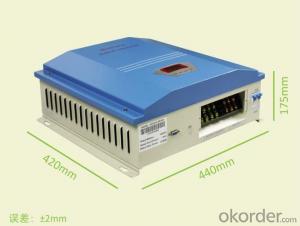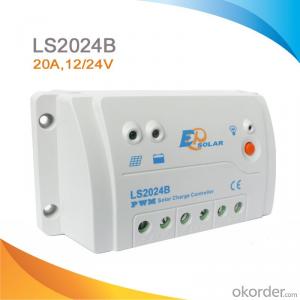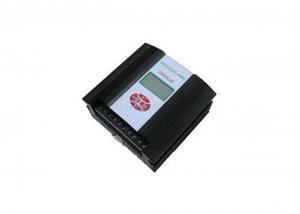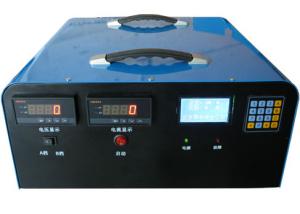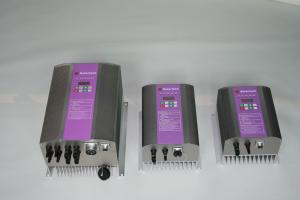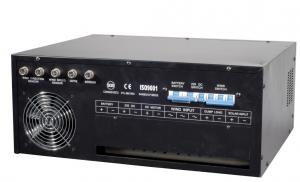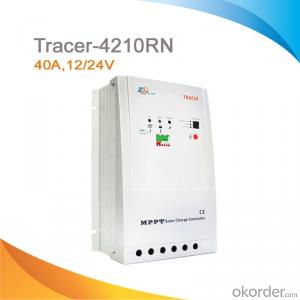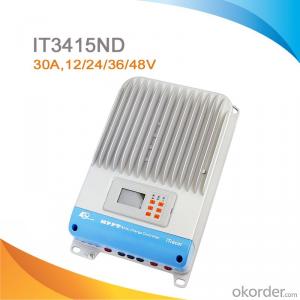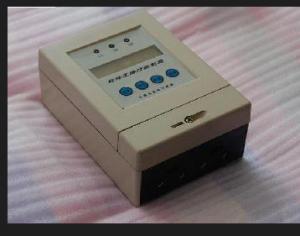Wind Solar Hybrid Controller 20KW PWM Stepless Unload Mode
- Loading Port:
- Shanghai
- Payment Terms:
- TT or LC
- Min Order Qty:
- 1 unit
- Supply Capability:
- 5000 unit/month
OKorder Service Pledge
OKorder Financial Service
You Might Also Like
I. PRODUCT INTRODUCTION
The wind/solar hybrid controller is control device which can control wind turbine and solar panel at the same time and transform wind and solar energy into electricity then store to the battery bank. Wind/solar hybrid controller is the most important part in off-grid system, whose performance has much effect on life expectancy and operational stability of the whole system, especially the battery expectancy. Or battery service life will be shortened by over-charge or over-discharge.
II. PERFORMANCE FEATURES
Superior military-grade components to ensure the product stability.
Perfect protection function, thus the system has higher reliability.
Check and set all operation parameters as requirement from LCD display.
Voltage limiting and current-limiting charge mode ensures battery in the best charging status.
PWM stepless unload mode, which burn the excess power into dump load, making the battery charging in best status.
III. APPLICATION AREAS
Stand alone wind/solar hybrid power station; Stand alone domestic household wind/solar hybrid power system.
Mobile communication base stations, expressway and other non-residential regions.
Coastal islands, remote mountainous, border posts for regions shortage of or without electricity.
Government demonstration projects, landscape lighting project.
IV. 20KW TECHNICAL PARAMETERS
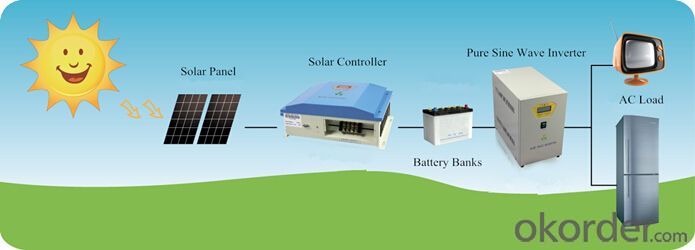
- Q: Can a solar controller be used with solar-powered refrigerators?
- Yes, a solar controller can be used with solar-powered refrigerators. A solar controller regulates the voltage and current from solar panels to ensure efficient charging of batteries. In the case of solar-powered refrigerators, a solar controller helps manage the power supply and prevent overcharging or damage to the batteries, allowing for optimal functioning of the refrigerator.
- Q: What is the role of a battery capacity monitor in a solar controller?
- The role of a battery capacity monitor in a solar controller is to accurately measure and report the level of charge in the battery bank. It helps to prevent overcharging or over-discharging of the batteries, which can lead to reduced lifespan and performance. The monitor allows the solar controller to efficiently regulate the charging and discharging process, ensuring that the batteries are maintained at optimal levels for maximum efficiency and longevity.
- Q: Can a solar controller be used with solar-powered medical equipment?
- Yes, a solar controller can be used with solar-powered medical equipment. A solar controller helps regulate the charging process of a solar panel, ensuring the proper voltage and current are supplied to the equipment's batteries. This helps protect the batteries from overcharging and damage, while maximizing the efficiency of the solar power system.
- Q: What is the purpose of the battery equalization feature on a solar controller?
- The purpose of the battery equalization feature on a solar controller is to ensure that all batteries in a solar power system are charged and discharged evenly. This helps to prevent imbalances in the battery bank, which can lead to reduced battery performance and shortened lifespan. By equalizing the charge levels of the batteries, the feature maximizes the overall efficiency and longevity of the system.
- Q: What is the maximum current rating of a solar controller?
- The maximum current rating of a solar controller can vary depending on the specific model and type of controller. It typically ranges from 10 amps to 60 amps, but higher-rated controllers are also available for larger solar systems.
- Q: I installed the force Norit, solar hot water controller on a regular, set, Sheung Shui, three keys, how to set the automatic Sheung Shui!
- Press and hold the water level key for 3 seconds, hear the "drop" sound, the display temperature of the two digits and the "time to add water" indicator light at the same time flashing, repeat the water level key to set the time to add water time. Set the time in Beijing plus the number of hours set into the regular water, such as set at 12 o'clock in the hour, regularly at 8 o'clock every day on the water, set the number of hours 20 (range 00-23), wait 5 seconds to automatically save and exit the "regular water" indicator light is on, the regular water function takes effect, after 8 o'clock every day will start the regular water. To cancel the time to add water: hold the water level key for 3 seconds, hear the "drop" after the "time to add water" indicator off, the time to add water function to cancel.
- Q: How does a solar controller handle power fluctuations from the solar panels?
- The solar controller, also referred to as a charge controller, plays a vital role in managing power fluctuations from solar panels in a solar power system. Its main function is to regulate and control the charging process of batteries, preventing overcharging or undercharging. To effectively handle power fluctuations from the solar panels, the solar controller employs various techniques. One of the primary methods is the utilization of maximum power point tracking (MPPT) technology. This technology enables the solar controller to constantly monitor the voltage and current output of the solar panels and adjust the charging parameters accordingly. During power fluctuations, the solar controller continuously tracks the maximum power point of the solar panels, which is the point at which they generate the most power. This ensures that the solar panels operate at their optimal efficiency, irrespective of fluctuations in sunlight intensity, temperature, or shading. By utilizing MPPT, the solar controller extracts the maximum available power from the solar panels and delivers it to the batteries. Additionally, the solar controller incorporates various protection mechanisms to handle power fluctuations. It includes features such as overvoltage protection, low voltage disconnect, and short circuit protection. These safety measures safeguard the solar panels, batteries, and other system components from potential damage caused by voltage spikes, sudden drops in voltage, or electrical faults. Furthermore, advanced solar controllers offer advanced algorithms and programming options. These allow the controller to dynamically adjust the charging parameters based on the solar panel's performance, battery condition, and system requirements. This adaptability ensures efficient power management and optimal battery charging, even in the face of power fluctuations. In summary, a solar controller utilizes MPPT technology, implements protective measures, and employs advanced algorithms to handle power fluctuations from solar panels. Its purpose is to ensure the smooth and efficient operation of the solar power system, maximize power generation, and prolong the lifespan of the batteries.
- Q: What is the typical standby power consumption of a solar controller?
- The standby power consumption of a solar controller can vary depending on the specific model and brand, but most modern controllers have a very low standby power consumption. On average, these controllers consume as little as 0.1 watts to about 1 watt when not actively controlling the solar system. Efficient design and advanced power-saving technologies enable these controllers to achieve such low standby power consumption. They are designed to minimize energy waste and only use a minimal amount of power when not actively controlling the solar system. It is important to consider that standby power consumption may also be influenced by factors like the size of the solar system, the complexity of the controller's features, and any additional accessories connected to the controller. Thus, it is always advisable to consult the manufacturer's product specifications for accurate information on the standby power consumption of a specific solar controller.
- Q: How do I connect a solar controller to a remote monitoring system?
- To connect a solar controller to a remote monitoring system, you need to follow these steps: 1. Ensure that your solar controller is compatible with a remote monitoring system. Check the product specifications and documentation for any specific requirements or recommendations. 2. Connect your solar controller to the remote monitoring system using the appropriate communication interface. This can be done through Ethernet, Wi-Fi, cellular network, or other available options. Refer to the manuals of both the solar controller and remote monitoring system for detailed instructions on how to establish this connection. 3. Configure the settings on your solar controller to enable communication with the remote monitoring system. This may involve setting up IP addresses, port numbers, or other network configurations. Follow the guidelines provided by the manufacturer of both the solar controller and remote monitoring system to ensure proper configuration. 4. Test the connection between the solar controller and remote monitoring system to ensure it is working correctly. Monitor the data being transmitted and received by the remote monitoring system to verify that it accurately reflects the status and performance of your solar controller. Remember, it is crucial to consult the user manuals and technical documentation of both the solar controller and remote monitoring system for specific instructions relevant to your particular setup.
- Q: Solar controller can not charge what is the reason the electric power will be less than the inverter with no fixed freezer! Solar energy simply did not charge into the electricity
- Direct charge protection point voltage: direct charge also called emergency charge, are fast charge, are generally in the battery voltage is low when the use of high current and relatively high voltage on the battery charge, but there is a control point, also known as protection points, Is the value in the table above, when charging the battery terminal voltage higher than the protection value, should stop charging. Direct charge protection point voltage is generally "overcharge protection point" voltage, the battery voltage when charging the battery can not be higher than the protection point, otherwise it will cause overcharge, the battery is damaged
Send your message to us
Wind Solar Hybrid Controller 20KW PWM Stepless Unload Mode
- Loading Port:
- Shanghai
- Payment Terms:
- TT or LC
- Min Order Qty:
- 1 unit
- Supply Capability:
- 5000 unit/month
OKorder Service Pledge
OKorder Financial Service
Similar products
Hot products
Hot Searches
Related keywords
